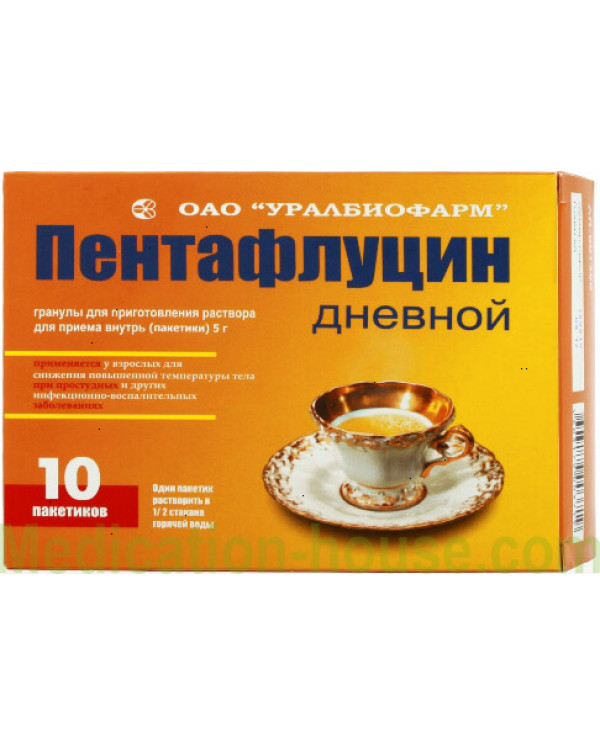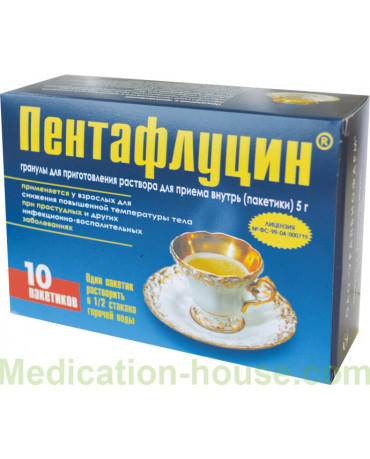Pentaflucin Daytime instruction
You can buy Pentaflucin Daytime on this page
Release form, composition and packaging
The drug Pentaflucin Daily is a white or slightly yellowish granule intended for the preparation of a solution taken internally. It is sold in cardboard packages in which there are 10 bags of medicine and an insert with recommendations for use. The active components of the drug are substances called ascorbic acid, calcium gluconate monohydrate, caffeine monohydrate, paracetamol and rutoside. Their dose in one package is 200, 200, 20, 500 and 20 milligrams, respectively. The auxiliary composition is represented by povidone, citric acid, sugar and saccharin. The manufacturer is Uralbiopharm OJSC. Reviews of Pentaflucin Daily are positive. Patients taking this drug have been shown to be highly effective. Helps relieve the course of acute respiratory illness, including viral etiology, minimizes concomitant symptoms, and also eliminates chills and fever.
pharmachologic effect
The composition of the drug is a combination of five medicinal substances, so the effect of Pentaflucin Daily is due to these components. The use of paracetamol can reduce heat and eliminate pain. It binds to cyclooxygenase type 1 and 2 at the level of the central nervous system, blocking it, and affects pain and thermoregulatory centers. Reception of ascorbic acid helps restore carbohydrate balance, normalize redox processes, regenerate tissue structures, improve blood coagulability and increase immunity. Caffeine stimulates the psychomotor centers, fights with increased drowsiness and fatigue, enhances the analgesic effect of paracetamol. Calcium gluconate increases the concentration of this macrocell in the body, prevents the development of excessive fragility of the vascular walls, resumes blood circulation in the capillaries and is considered an antihistamine. Rutoside neutralizes the destructive effect of free radicals and minimizes increased vascular permeability. Order Pentaflucin Daytime with delivery in Moscow and other cities of Russia is available in our online pharmacy.
Indications
The instructions of the drug say that it should be prescribed to adult patients for the symptomatic treatment of acute respiratory disease and acute respiratory viral infection, accompanied by fever, fever, cephalgia and myalgia.
Contraindications
Pentaflucin Daily and analogues cannot be used by patients with: - excessive susceptibility of the constituent agents; - severe renal or hepatic dysfunction; - hemopoiesis pathologies, in which the risk of bleeding is increased; - deficiency of glucose-6-phosphate dehydrogenase; - fructose intolerance; - malabsorption of glucose-galactose; - insufficiency of sucrose-isomaltose; - insufficient age (less than 18 years). If the patient has constitutional hyperbilirubinemia, treatment should be carried out with caution. Patients suffering from diabetes mellitus, when taking the drug, you need to consider that in the composition there is sugar, the proportion of which is 0.33 bread units.
Dosage and administration
The medicine is intended for oral use. Before taking the granules from the bag are dissolved in a glass half full of hot water. Drink a fresh solution 3-4 times a day, 1 packet at a time.
Side effects
Often, the use of the drug in compliance with the dose indicated in the instructions does not lead to the development of undesirable side symptoms. There is information that therapy can cause allergic manifestations, urge to vomit and vomiting itself, cephalgia, a feeling of weakness and loss of equilibrium. Taking ascorbic acid can cause an increase in the frequency of urination, an increase in the concentration of oxalates in the urine, kidney stone disease, irritation of the mucous membrane covering the walls of the gastrointestinal tract, skin rashes and redness, an increase in blood sugar and its appearance in urine. Calcium gluconate therapy often provokes difficult bowel movements, irritation of the walls of the stomach and intestines. Caffeine, however, has the property of causing nervous system overexcitation, excessive anxiety, cephalalgia, dizziness, increased reflexes, rapid surface breathing, sleep disturbance, abnormal rapid heartbeat, increased blood pressure, nausea and vomiting, and aggravation of the ulcer. Paracetamol can lead to pain in the epigastric region, a decrease in hemoglobin, platelets and the release of methemoglobin in the blood, skin rashes, hives, Quincke's edema, and kidney and liver problems. A substance called rutoside sometimes causes skin rashes, upset stomach, heartburn and vomiting, headaches, and flushing of the face.
Overdose
Taking a medicine in a dosage significantly higher than the norm can lead to the development of undesirable symptoms. An excessive dose of paracetamol leads to pallor of the skin, attacks of nausea and vomiting, complete loss of appetite, pain in the epigastric region, improper absorption and balance of sugar, and increased accumulation of acids in the body. Toxic effects on the liver may occur after 1-2 days after taking a large dosage. Severe hepatic dysfunction, inflammation of the brain and pancreas, coma, death, renal impairment, increased heart rate usually occur with severe intoxication, when the dose of the substance is 10 grams or more. If symptoms of an overdose are identified, the patient must thoroughly rinse the stomach, drink enterosorbent and seek help from specialists.
Drug interaction
Barbiturates, phenytoin, anticonvulsants, as well as rifampicin, carbamazepine and zidovudine are extremely undesirable to combine with the drug described in the instructions. Medicines with uricosuric action under the influence of paracetamol become less effective. Combined treatment with paracetamol and anticoagulants leads to increased effectiveness of the latter. When combining this medication with alcohol increases the risk of acute inflammation of the pancreas. Non-steroidal anti-inflammatory drugs, interacting with paracetamol, often cause "analgesic" nephropathy, necrotic damage to the kidneys and impaired functioning. The combined use of diflunisal and paracetamol leads to an increase in the concentration of the latter in the blood, due to which there is a toxic effect on the liver. Means with a myelotoxic effect when mixed with paracetamol have a toxic effect on blood formation. Cimetidine, ciprofloxacin, norflaxacin and oral contraceptives, interacting with caffeine, slow down the excretion of the latter and increase its level in the blood. The drug, called Mexiletine, also slows down the metabolism of caffeine, while nicotine-containing drugs, on the contrary, accelerate it. Medications that slow down the reaction of monoamine oxidase, when combined with a high dosage of caffeine, can cause abnormal heart rate and hypertension. Combined caffeine intake (in large doses) with procabazine, selegipine and phrasopidone often provokes arrhythmia and an increase in systolic and diastolic blood pressure. When combining caffeine with cardiac glycosides, the effectiveness and toxicity of the latter increase. Beta-adrenoreceptor blockers, interacting with caffeine, often lead to a decrease in the effectiveness of both drugs. Medicines that expand the lumen of the bronchi, when combined with caffeine, give excessive stimulation of the central nervous system and various toxic reactions. Combined caffeine therapy with theophylline and other xanthines slows down the metabolism of the latter and increases the toxic effect on the body. Benzylpenicillin and tetracyclines when combined with ascorbic acid grow in blood counts. When combining ascorbic acid with anticoagulants and heparin, the effectiveness of the latter decreases. Taking this substance with medications containing iron gives the best digestibility of the latter. Aspirin, oral contraceptives, freshly squeezed juices and alkaline pH water decrease the effectiveness of ascorbic acid. The simultaneous administration of aspirin with ascorbic acid reduces the degree of assimilation of the latter by 1/3. Isoprenaline, interacting with ascorbic acid, becomes less effective. Quinidine when combined with calcium gluconate slows the conduction of the ventricles of the heart and gives a more toxic effect on the body. Tetracyclines with combined therapy with calcium gluconate have less antibacterial effect. Thiazide diuretics when taken with calcium gluconate increase the risk of hypercalcemia. When combining calcium gluconate with phenytoin, the degree of absorption of the latter decreases. This substance is strictly forbidden to be used simultaneously with sulfates, salicylates and carbonates. Ascorbic acid increases the effectiveness of rutoside.
Special instructions
Driving and working with responsible equipment during the period of use of the described drug should be carried out in compliance with safety precautions.
Terms and conditions of storage
Packets with granules to keep away from children, sun and moisture. Store in a place where the temperature does not exceed +25 ° C. Subject to the above conditions, the medicine is suitable for 2 years.
Terms of sell
You can buy Pentaflucin Daytime without a prescription.


